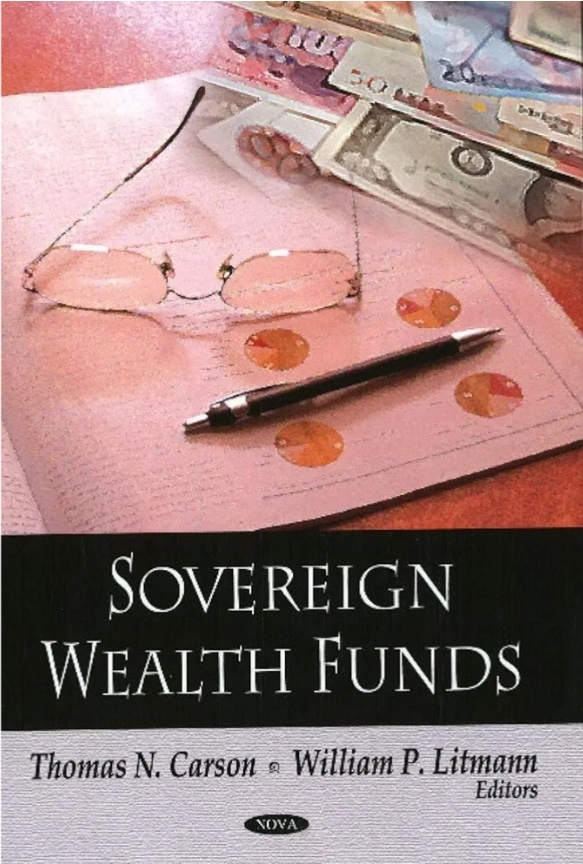Sovereign Wealth Funds, edited by Thomas N. Carson and William P. Litmann, is a comprehensive examination of state-owned investment funds, commonly known as sovereign wealth funds (SWFs). Published in 2009 by Nova Science Publishers, this 369-page volume delves into the multifaceted aspects of SWFs, including their economic foundations, investment strategies, governance structures, and the policy issues they present on both national and international stages.
Overview of Sovereign Wealth Funds:
SWFs are investment funds owned and managed by national governments. As of the book’s publication, these funds managed assets estimated between $1.9 and $2.9 trillion, with projections to grow beyond $12 trillion by 2015. This rapid expansion is attributed to soaring commodity prices and substantial trade surpluses in several emerging market economies. The book provides a detailed analysis of the origins and purposes of SWFs, highlighting their role in managing national wealth and stabilizing economies.
Key Themes and Topics:
Economic Foundations and Growth:
- The editors explore the economic conditions that have led to the creation and proliferation of SWFs, particularly focusing on countries with significant natural resource revenues and trade surpluses.
Investment Strategies:
- An in-depth look at how SWFs allocate their assets across various classes, including equities, bonds, real estate, and alternative investments. The book discusses the long-term investment horizons of SWFs and their impact on global financial markets.
Governance and Transparency:
- The issue of transparency is a central concern, as many SWFs have been criticized for their opaque operations. The editors examine governance structures and the efforts to implement standards that promote accountability and openness.
Policy and Regulatory Responses:
- The book addresses the policy challenges that SWFs pose to host countries, including potential political motivations behind investments and national security considerations. It also covers the legislative and regulatory measures adopted by various nations in response to the growing influence of SWFs.
Case Studies:
- Through specific examples, the editors illustrate the diverse nature of SWFs, analyzing funds from different regions and their unique approaches to investment and governance.
Relevance and Impact:
This volume serves as a critical resource for policymakers, economists, financial analysts, and scholars interested in understanding the complexities of sovereign wealth funds. By providing a thorough exploration of SWFs’ structures and operations, the book contributes to the broader discourse on global finance and the interplay between state-owned investment entities and international markets.
For those seeking to delve deeper into the subject, “Sovereign Wealth Funds” edited by Carson and Litmann offers a foundational understanding of the economic and political dimensions of these powerful financial institutions.
Detailed Analysis of the Origins and Purposes of Sovereign Wealth Funds (SWFs)
Sovereign Wealth Funds (SWFs) have emerged as influential players in global finance, managing vast pools of state-owned capital. Their origins, purposes, and roles in economic stabilization and wealth management stem from a combination of historical, economic, and geopolitical factors.
Origins of Sovereign Wealth Funds
The concept of SWFs dates back to the mid-20th century, though their significance has grown exponentially in recent decades. Their formation can be categorized into key historical and economic developments:
Early Foundations (Pre-1970s)
- The first SWF, the Kuwait Investment Authority (KIA), was established in 1953 to manage excess oil revenues and diversify the country’s wealth for future generations.
- Similarly, the Kiribati Revenue Equalization Reserve Fund (1956) was created to manage revenues from phosphate mining, ensuring long-term economic stability once resources were depleted.
- These early funds were driven by concerns about economic sustainability, recognizing the need to preserve wealth beyond finite natural resources.
Expansion During the Oil Boom (1970s-1990s)
- The 1970s oil crises led to an unprecedented rise in oil prices, generating vast surpluses for oil-exporting countries such as Saudi Arabia, Norway, and the UAE.
- To manage these revenues effectively, oil-producing nations established SWFs to invest in diversified assets and protect against market volatility.
- The Abu Dhabi Investment Authority (ADIA), founded in 1976, became one of the largest and most influential SWFs, investing petrodollars in international markets to safeguard the UAE’s economy.
Growth in Emerging Markets (2000s-Present)
- As global trade surpluses expanded, non-commodity-exporting nations, such as China and Singapore, established SWFs to manage foreign exchange reserves.
- China’s China Investment Corporation (CIC) (2007) was created to manage the country’s $3 trillion in reserves, focusing on diversifying assets beyond low-yield U.S. Treasury bonds.
- The global financial crisis of 2008 further emphasized the importance of SWFs as stabilizing forces in financial markets.
Purposes and Objectives of SWFs
SWFs serve multiple purposes depending on a country’s economic structure, resource base, and financial goals. Their objectives typically fall into the following categories:
Managing National Wealth for Future Generations
- Countries rich in finite natural resources (e.g., oil, gas, minerals) use SWFs to convert volatile resource revenues into stable, long-term assets that can benefit future generations.
- Examples:
- Norway’s Government Pension Fund Global (GPFG): Created in 1990, this fund invests oil revenues in diversified global assets, ensuring economic sustainability beyond oil depletion.
- Alaska Permanent Fund (U.S.): Established in 1976, it distributes oil revenues through annual dividends to state residents while investing in global markets.
Economic Stabilization and Crisis Mitigation
- SWFs act as financial buffers during economic downturns, counterbalancing revenue shortfalls due to commodity price volatility or global financial crises.
- Examples:
- Chile’s Economic and Social Stabilization Fund (ESSF): Used to stabilize public finances by offsetting fluctuations in copper prices, which are a major source of government revenue.
- Saudi Arabia’s Public Investment Fund (PIF): Played a crucial role in sustaining government spending amid falling oil prices in the mid-2010s.
Diversifying National Investment Portfolios
- Many countries establish SWFs to reduce reliance on a single revenue stream (e.g., oil or commodities) and diversify their investment holdings across global equities, bonds, real estate, and infrastructure.
- Examples:
- Singapore’s Temasek Holdings: Invests in multiple industries, including technology, healthcare, and finance, reducing exposure to domestic economic fluctuations.
- UAE’s Mubadala Investment Company: Focuses on high-growth industries such as aerospace, renewable energy, and artificial intelligence.
Enhancing National Economic Development
- Some SWFs prioritize domestic investments to support infrastructure, job creation, and economic development.
- Examples:
- China Investment Corporation (CIC): Invests in strategic industries such as technology and manufacturing to enhance China’s global competitiveness.
- Russia’s National Wealth Fund (NWF): Supports infrastructure and social programs to boost economic resilience.
Geopolitical and Strategic Influence
- Some SWFs serve as tools for advancing a country’s geopolitical and strategic interests by acquiring stakes in key global industries and securing long-term economic partnerships.
- Examples:
- Qatar Investment Authority (QIA): Has invested in European luxury brands, real estate, and sports franchises to enhance Qatar’s global presence.
- Saudi Arabia’s PIF: Invests in high-profile technology companies like Uber and gaming ventures to position the country as a global tech hub.
The Role of SWFs in Stabilizing Economies
SWFs contribute to economic stability in various ways, ensuring resilience against financial shocks, external crises, and commodity price fluctuations.
Counter-Cyclical Economic Policies
- SWFs help governments maintain fiscal stability by smoothing revenue fluctuations.
- Example:
- Chile’s ESSF: Injects funds into the economy during economic downturns, preventing severe budget cuts.
Currency Stabilization and Foreign Exchange Management
- By managing large foreign exchange reserves, SWFs prevent excessive currency appreciation, which can harm export competitiveness.
- Example:
- China Investment Corporation (CIC): Helps regulate China’s massive trade surplus by investing excess foreign currency holdings abroad.
Providing Liquidity During Financial Crises
- SWFs often act as stabilizers during market downturns, injecting capital into struggling financial institutions and ensuring liquidity.
- Example:
- Abu Dhabi’s SWFs: Invested in Western financial institutions such as Citigroup during the 2008 financial crisis, helping restore confidence in global markets.
Promoting Economic Diversification
- By investing in non-traditional sectors, SWFs reduce reliance on volatile industries (e.g., oil, commodities).
- Example:
- Norway’s GPFG: Allocates funds to green energy and technology investments to prepare for a post-oil economy.
Sovereign Wealth Funds play a crucial role in managing national wealth, stabilizing economies, and advancing long-term economic strategies. Originating from resource-rich nations and economies with trade surpluses, SWFs have evolved into powerful investment vehicles that shape global finance. Their ability to mitigate financial crises, promote economic diversification, and ensure intergenerational wealth preservation underscores their growing importance in an increasingly interconnected world.
As SWFs continue to expand in influence, governments must balance financial objectives with transparency, governance, and geopolitical considerations to maximize their benefits while minimizing risks.
Negatives of Sovereign Wealth Funds (SWFs)
While Sovereign Wealth Funds (SWFs) offer numerous economic benefits, they also pose significant challenges and risks. These issues range from transparency concerns to potential geopolitical manipulation. Below are the key negatives associated with SWFs:
Lack of Transparency and Accountability
Many SWFs operate with limited public disclosure, making it difficult to assess their investment strategies, financial health, and political motivations.
- Opaque Operations: Some funds, especially those from authoritarian regimes, provide minimal financial reporting, raising concerns about corruption and mismanagement.
- Limited Oversight: Unlike private investment funds, SWFs are often not subject to the same level of regulatory scrutiny, which can lead to inefficient or politically motivated investment decisions.
- Example: The China Investment Corporation (CIC) has faced criticism for a lack of transparency regarding its offshore investments and political influences.
Political and Geopolitical Risks
SWFs are controlled by governments, meaning their investments can be driven by political rather than purely financial motives. This creates tensions between nations and raises security concerns.
- Strategic Asset Acquisition: Countries with SWFs have been accused of using them to gain control over critical industries in foreign nations, such as energy, technology, and infrastructure.
- Economic Weaponization: Host nations worry that SWFs could be used to exert economic pressure or influence domestic policies.
- Example: The Qatar Investment Authority (QIA) has faced scrutiny over its purchases of strategic assets in Europe, including stakes in British and French companies, raising concerns over foreign influence.
Market Distortion and Financial Risks
Due to their massive size, SWFs can disrupt financial markets and contribute to economic imbalances.
- Asset Price Inflation: Large-scale investments by SWFs can drive up asset prices, creating bubbles in real estate, stocks, and other financial markets.
- Market Volatility: Sudden investment shifts by SWFs—such as large sell-offs—can destabilize global markets.
- Example: During the 2008 financial crisis, SWFs were initially seen as stabilizers, but their withdrawal from some markets contributed to volatility.
Poor Investment Decisions and Inefficiencies
Because SWFs are state-controlled, they may prioritize national interests over financial returns, leading to inefficiencies.
- Politically Motivated Investments: Governments may pressure SWFs to invest in failing domestic industries for political reasons rather than sound financial logic.
- Low Return on Investments: Some SWFs have historically underperformed due to mismanagement or lack of expertise.
- Example: Russia’s National Wealth Fund (NWF) has been criticized for politically motivated investments that yielded poor returns, such as supporting state-owned enterprises rather than maximizing profits.
National Sovereignty and Security Concerns
Host countries often fear that SWF investments could lead to foreign control over key domestic industries.
- National Security Threats: Investments in strategic sectors such as defense, telecommunications, and infrastructure can create risks if the investor government has conflicting interests.
- Example: The U.S. has blocked several SWF-related transactions under CFIUS (Committee on Foreign Investment in the United States) regulations, including attempts by Chinese and Middle Eastern funds to acquire stakes in American technology and defense companies.
Resource Dependency and Overreliance
Many SWFs are funded by natural resource revenues (e.g., oil, gas), which can create economic vulnerabilities.
- Revenue Volatility: A drop in commodity prices can shrink SWF assets, leading to budget shortfalls.
- Failure to Diversify Economies: Some nations rely too heavily on their SWFs instead of investing in economic diversification.
- Example: Saudi Arabia’s Public Investment Fund (PIF) is heavily dependent on oil revenues, making it vulnerable to fluctuations in global oil prices.
Impact on Domestic Economies
In some cases, SWFs prioritize foreign investments over domestic economic development, leading to capital outflows and limited local economic benefits.
- Capital Flight: SWFs often invest abroad instead of supporting domestic businesses, limiting job creation at home.
- Example: Norway’s Government Pension Fund Global (GPFG) primarily invests internationally rather than domestically to avoid overheating Norway’s economy.
While SWFs serve as powerful financial tools for wealth management and economic stability, they also pose serious risks related to transparency, geopolitics, market distortion, and national security. Addressing these issues requires strong governance, regulatory oversight, and a balance between financial goals and national interests.







